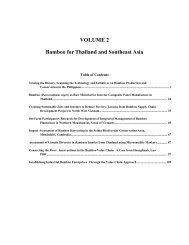WBC-VIII-Vol.4 – Resources – Forestry, Plantations and ... - BambuSC
WBC-VIII-Vol.4 – Resources – Forestry, Plantations and ... - BambuSC
WBC-VIII-Vol.4 – Resources – Forestry, Plantations and ... - BambuSC
You also want an ePaper? Increase the reach of your titles
YUMPU automatically turns print PDFs into web optimized ePapers that Google loves.
Table 1: Linear relationship between above ground biomass of bamboo plant components (y<br />
Kg pole -1 ) <strong>and</strong> height (x1, m), girth to height at 1m (x2, m) & girth to height at 1.5m (x3, m).<br />
S.N. Biomass (Kg<br />
plant -1 )<br />
Intercept (a) Slope (b1) Slope<br />
(b2)<br />
Slope<br />
(b3)<br />
1 Fresh weight -1.30 0.463 -3.74 30.2 0.998<br />
2 Dry Weight -0.809 0.393 -6.68 18.43 0.976<br />
Above ground biomass produced by D. asper at two aspects varied. Biomass produced in two years after the<br />
plantation was 17 per cent higher at the hill top as compared to river bank on the fresh weight basis. Average<br />
biomass produced was 542.24 kg ha -1 <strong>and</strong> 450.06 kg ha -1 at ARS Majhera <strong>and</strong> Jarmila, respectively. Dry weight<br />
was recorded approximately 63 per cent less than the fresh weight (Table 2). Average biomass on the basis of<br />
dry weight was 208.43 kg ha -1 at ARS Majhera which was 19.8 per cent higher than Jarmila (166.99 kg ha -1 ).<br />
Table 2: Above ground biomass produced by D. asper at two aspects<br />
Average Biomass (Kg ha -1 S.N. Treatments<br />
)*<br />
ARS, Majhera<br />
Jarmila<br />
(Hill Top)<br />
(River bank)<br />
1 Fresh weight 542.24 450.06<br />
2 Dry weight 208.43 166.99<br />
* On the basis of one pole/plant<br />
Soil carbon concentration in both the aspects was estimated up to 20 cm depth. Soil carbon of the hill top was<br />
found higher than the soil carbon of river bank. Negative correlation was found between the per cent soil carbon<br />
<strong>and</strong> radial distance from the centre of the plant (Table 3). Per cent soil carbon increased by 64-70 at ARS<br />
Majhera <strong>and</strong> 32-60 at Jarmila due to litter deposition (leaf fall) as compared to control.<br />
Table 3: Soil carbon due to plantation of D. asper<br />
S.N. Radial distance from centre of Per cent Organic carbon<br />
plant ARS, Majhera<br />
Jarmila<br />
(Hill Top)<br />
(River bank)<br />
1 0.5 m 2.57 0.97<br />
2 1.0 m 2.15 0.58<br />
3 Control 0.78 0.39<br />
There are few studies on biomass production by D. asper. Mathematical regression models are commonly<br />
practiced in determining the biomass of forest all over the world because it does not damage the growth of the<br />
<strong>VIII</strong> World Bamboo Congress Proceedings Vol 4-92<br />
R 2




